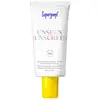What's inside
What's inside
 Key Ingredients
Key Ingredients

 Benefits
Benefits

 Concerns
Concerns

 Ingredients Side-by-side
Ingredients Side-by-side

Butyl Methoxydibenzoylmethane 3%
UV AbsorberHomosalate 8%
Skin ConditioningEthylhexyl Salicylate 5%
UV AbsorberOctocrylene 4%
UV AbsorberIsododecane
EmollientDimethicone Crosspolymer
Emulsion StabilisingDimethicone/Bis-Isobutyl PPG-20 Crosspolymer
EmollientPolymethylsilsesquioxane
Isohexadecane
EmollientDicaprylyl Carbonate
EmollientMeadowfoam Estolide
Skin ConditioningCaprylic/Capric Triglyceride
MaskingPolyester-7
Skin ConditioningNeopentyl Glycol Diheptanoate
EmollientLithothamnion Calcareum Extract
Skin ConditioningCaprylyl Glycol
EmollientButyrospermum Parkii Butter
Skin ConditioningJojoba Esters
EmollientMannitol
HumectantBoswellia Serrata Resin Extract
SmoothingLecithin
EmollientMicrocrystalline Cellulose
AbsorbentDiatomaceous Earth
AbrasiveZinc Sulfate
AntimicrobialSilica
AbrasiveTocopherol
AntioxidantButyl Methoxydibenzoylmethane 3%, Homosalate 8%, Ethylhexyl Salicylate 5%, Octocrylene 4%, Isododecane, Dimethicone Crosspolymer, Dimethicone/Bis-Isobutyl PPG-20 Crosspolymer, Polymethylsilsesquioxane, Isohexadecane, Dicaprylyl Carbonate, Meadowfoam Estolide, Caprylic/Capric Triglyceride, Polyester-7, Neopentyl Glycol Diheptanoate, Lithothamnion Calcareum Extract, Caprylyl Glycol, Butyrospermum Parkii Butter, Jojoba Esters, Mannitol, Boswellia Serrata Resin Extract, Lecithin, Microcrystalline Cellulose, Diatomaceous Earth, Zinc Sulfate, Silica, Tocopherol
Homosalate
Skin ConditioningEthylhexyl Methoxycinnamate
UV AbsorberEthylhexyl Salicylate
UV AbsorberZinc Oxide
Cosmetic ColorantAloe Barbadensis Leaf Juice
Skin ConditioningAmodimethicone
Water
Skin ConditioningButylene Glycol
HumectantButyloctyl Salicylate
Skin ConditioningC12-15 Alkyl Benzoate
AntimicrobialCamellia Sinensis Extract
AntioxidantCaprylic/Capric Triglyceride
MaskingCarbomer
Emulsion StabilisingCitric Acid
BufferingCitrullus Lanatus Fruit Extract
Skin ConditioningCeramide Ng
Skin ConditioningCocamidopropyl Betaine
CleansingColloidal Oatmeal
AbsorbentCyclopentasiloxane
EmollientCyclotetrasiloxane
EmollientDaucus Carota Sativa Extract
PerfumingFerulic Acid
AntimicrobialGlycerin
HumectantGlyceryl Caprylate
EmollientGlyceryl Stearate
EmollientGlyceryl Undecylenate
EmollientHyaluronic Acid
HumectantHydrogenated Methyl Abietate
Hydroxypropyl Cyclodextrin
MaskingLeuconostoc/Radish Root Ferment Filtrate
AntimicrobialMelaleuca Alternifolia Leaf Oil
AntioxidantNiacinamide
SmoothingPalmitoyl Tetrapeptide-7
Skin ConditioningPalmitoyl Tripeptide-1
Skin ConditioningPalmitoyl Tripeptide-38
Skin ConditioningPolysorbate 20
EmulsifyingTerminalia Ferdinandiana Seed Oil
AntioxidantThymus Vulgaris Extract
PerfumingHomosalate, Ethylhexyl Methoxycinnamate, Ethylhexyl Salicylate, Zinc Oxide, Aloe Barbadensis Leaf Juice, Amodimethicone, Water, Butylene Glycol, Butyloctyl Salicylate, C12-15 Alkyl Benzoate, Camellia Sinensis Extract, Caprylic/Capric Triglyceride, Carbomer, Citric Acid, Citrullus Lanatus Fruit Extract, Ceramide Ng, Cocamidopropyl Betaine, Colloidal Oatmeal, Cyclopentasiloxane, Cyclotetrasiloxane, Daucus Carota Sativa Extract, Ferulic Acid, Glycerin, Glyceryl Caprylate, Glyceryl Stearate, Glyceryl Undecylenate, Hyaluronic Acid, Hydrogenated Methyl Abietate, Hydroxypropyl Cyclodextrin, Leuconostoc/Radish Root Ferment Filtrate, Melaleuca Alternifolia Leaf Oil, Niacinamide, Palmitoyl Tetrapeptide-7, Palmitoyl Tripeptide-1, Palmitoyl Tripeptide-38, Polysorbate 20, Terminalia Ferdinandiana Seed Oil, Thymus Vulgaris Extract
 Reviews
Reviews

Ingredients Explained
These ingredients are found in both products.
Ingredients higher up in an ingredient list are typically present in a larger amount.
This ingredient is an emollient, solvent, and texture enhancer. It is considered a skin-softener by helping the skin prevent moisture loss.
It helps thicken a product's formula and makes it easier to spread by dissolving clumping compounds.
Caprylic Triglyceride is made by combining glycerin with coconut oil, forming a clear liquid.
While there is an assumption Caprylic Triglyceride can clog pores due to it being derived from coconut oil, there is no research supporting this.
Learn more about Caprylic/Capric TriglycerideEthylhexyl Salicylate is an organic compound used to block UV rays. It primarily absorbs UVB rays but offers a small amount of UVA protection as well.
Commonly found in sunscreens, Ethylhexyl Salicylate is created from salicylic acid and 2-ethylhexanol. You might know salicylic acid as the effective acne fighter ingredient and BHA.
The ethylhexanol in this ingredient is a fatty alcohol and helps hydrate your skin, similar to oils. It is an emollient, which means it traps moisture into the skin.
According to manufacturers, Ethylhexyl Salicylate absorbs UV wavelength of 295-315 nm, with a peak absorption at 307-310 nm. UVA rays are linked to long term skin damage, such as hyperpigmentation. UVB rays emit more energy and are capable of damaging our DNA. UVB rays cause sunburn.
Learn more about Ethylhexyl SalicylateHomosalate is a chemical sunscreen filter that provides protection in the UV-B range (280nm - 320 nm), with a peak protection at 306 nm. It is internationally approved for use in sunscreens.
Homosalate is not photo-stable, meaning it's strength as a UV filter degrades over time with exposure to the sun. Because of this, it's often used in combination with other chemical sunscreen filters as avobenzone (which protects from the UV-A range). Homosalate also helps act as a solvent for harder-to-dissolve UV filters.
(Part of the reason that sunscreens need to be frequently re-applied is due to the photo instability of many chemical sunscreen filters)
Currently, homosalate is approved in concentrations up to 10% in the EU and 15% in the US. The FDA is currently doing further research on the effects of homosalate, and it is possible that these approved concentrations will change in the future.
Learn more about Homosalate